
Ed Valfre, photography.
“…the era of neoliberal revanchism was characterized by a discourse of revenge against minorities, the working class, feminists, enviromental activists, gays and lesbians, and recent immigrants: the political enemies of the bourgeois political elite and their supporters.”
Tom Slater
(on Neil Smith)
“…this triple exclusion, the prison and the criminal justice system more broadly contribute to the ongoing reconstruction of the ‘imagined community’ of Americans around the polar opposition between praiseworthy ‘working families’—implicitly white, suburban, and deserving—and the despicable ‘underclass’ of criminals, loafers, and leeches, a two-headed antisocial hydra personified by the dissolute teenage ‘welfare mother’ on the female side and the dangerous street ‘gang banger’ on the male side—by definition dark-skinned, urban and undeserving. The former are exalted as the living incarnation of genuine American values, self-control, deferred gratification, subservience of life to labour; the latter is vituperated as the loathsome embodiment of their abject desecration, the ‘dark side’ of the ‘American dream’ of affluence and opportunity for all, believed to flow from morality anchored in conjugality and work. And the line that divides them is increasingly being drawn, materially and symbolically, by the prison.”
Loic Waquant
“Patients do not easily believe us when we tell them about the unconscious sense of guilt. They know well enough by what torments–the pangs of conscience–a conscious sense of guilt, a consciousness of guilt, expresses itself, and they therefore cannot admit that they could harbour exactly analogous impulses in themselves without being in the least aware of them. We may, I think, to some extent meet their objection if we give up the term “unconscious sense of guilt,” which is in any case psychologically incorrect, and speak instead of a “need for punishment,” which covers the observed state of affairs just as aptly.”
Sigmund Freud
The Economic Problem of Masochism (1924)
The image of the city is not at all the same as the city one drives through, or walks through or lives in. The image is manufactured by both the culture industry and the government. And it is partly what has aided the acceleration of the hostility toward the poor, the blaming of minorities and unemployed, of all marginal segments of the society. And this blame is a component of the process of industrial scale gentrification going on in U.S. urban centers for the last fifteen years.
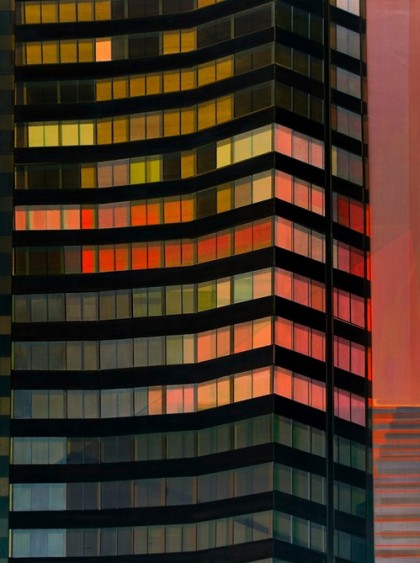
Cecile van Hanja
The late Neil Smith coined the term “revanchist city”, and its a very useful term, because in fact the city is incrementally sliding back to a feudal space, or rather to the new feudalist space. The various Hollywood narratives that make use of the idea of “urban” almost always predicate this idea and image upon the borderlands of black ghettos, or Latino barrios. That beyond this imaginary boundaries lie the restless savages. Countless films have made use of the white station wagon taking a wrong freeway turn off and ending up in the dark unknown regions of the urban. City centers, business areas, are presented as friendly, bustling, full of industrious and responsible mostly white people.
Gentrification in 21st century America is an exercise, in terms of image, in recreating the authenticity of the outside. Enter the mall, and the desired effect of the designers and architects is to make the shopper feel as she or he hadnt entered anywhere at all. The street is now indoors, except its not a street, its not even a simulacra of a street. It’s something else. It is a faux public space in which access or continued occupation is based on the at least apperance of ability to shop.
“The dismantling of urban commons has accelerated and assumed a belligerency in recent years under the impetus of a plethora of urban fears.”
Steven Flusty
Twenty five years ago Mike Davis wrote about the lurch toward authoritarian space, and Flusty pointed to ‘interdictory spaces’; malls, business squares between high rise, industrial parks even, or parking garages with high meter rates. These spaces serve as filtering devices for the ruling class. Riff raff, the homeless, the *other* can be stopped, even expelled. Today the drastic uptick in private security patrols means these effects are more efficiently enforced. Traditional inclusive commons allow for the exchange of ideas as well as goods, and malls restrict both.
Flusty points out that widening security measures means more boundaries. A proliferation of boundaries, and hence of border regions.
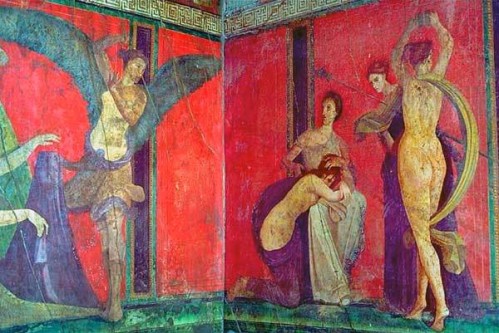
Villa of the Mysteries, Pompeii
Neil Smith also pointed to Giuliani’s election as Mayor of New York in 1994 as the watershed for revanchist retaking of public space from the undersirables (the people) and returning it to the bourgeois elite and ruling class.
Gordon MacCleod wrote:
“…Giuliani vowed unequivocally to cut public services – especially welfare to the poor (now inscribed as ‘workfare’), public housing construction, and the city’s public university system – while also initiating more stringent anti-immigrant legislation. Indeed in his address to a small coterie of newspaper editors, the Mayor momentously revealed his aspiration to encourage the poorest of the city’s population, of course those most dependent on public services, to move out of the city. “
This of course followed the Reagan era remarketing of white bourgeois values (masking what are really ruling elite values). The new feudalism that Reagan pointed toward was expressed in the medieval world by Royalty, aristocracy, clergy, and finally elite merchants. The new ownership class found their clergy in banking and law. The rest, including the new court jesters of the culture industry are just privileged merchants, selling themselves. Neil Smith saw Giuliani’s sweeping cut backs as…
“… a vendetta against the most oppressed – workers and ‘welfare mothers’, immigrants and gays, people of color and homeless people, squatters, anyone who demonstrates in public. They are excoriated for having stolen New York from a white middle class that sees the city as its birthright. Blaming the victim has been raised from a common political tactic to a matter of established policy.”
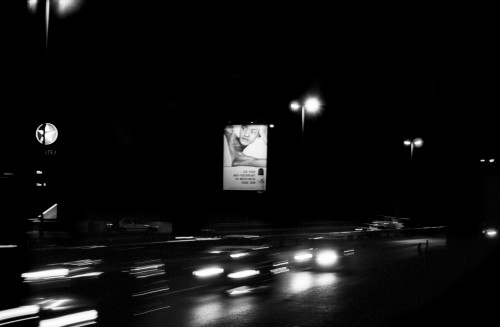
Santu Mokogfeng, photographer
This sense of needing protection, felt by the white establishment, carried with it the metaphors of infection and contagion. The rich are always afraid of catching something from the poor. Often the deepest fear, usually unconscious, is that they will catch a fatal case of ‘poverty’.
The concrete policing practices of law enforcement have, of course, become increasingly brutal and sadistic. This tendency has always existed in Capitalism, but as the neo liberal ethos dug in, there was permission given to jettison empathy and compassion as just weakness, something not needed in the new war on the poor. Sentencing laws spiked, three strikes, zero tolerance, and while the assumption seems to exist in liberal America that this was a province of rock ribbed Republicans, the reality is that the white liberal class was perhaps even less compassionate. The Republican would let you smoke as they executed you, the liberal would deny you that last cigarette because smoking was bad for your health. The white homeowner, member of neighborhood watch, believer in more police, is the Reagan Democrat, and that is exactly the class still supporting Obama. For Obama openly expresses his contempt for poor people, black, brown or white. The Obama justice department has simply continued the trajectory of Giuliani, and Reagan. And that is in part, large part perhaps, implemented by the writing of mental maps for the U.S. affluent class. The bourgeoise find anxiety in borders without clarity. And there is no clarity without enclosure and no enclosure without barriers. Space is marked out by barriers now. Walls are no longer dividers between parts, or simply architectural expressions of privacy and seclusion, but barries that protect property, person, and, they protect a metaphoric sense of owned white space. They additionally mirror the prison.
The architecture of city today reflects the emphasis on exclusionary privatized space and the limiting of any genuine commons. It is a landscape of paranoia.
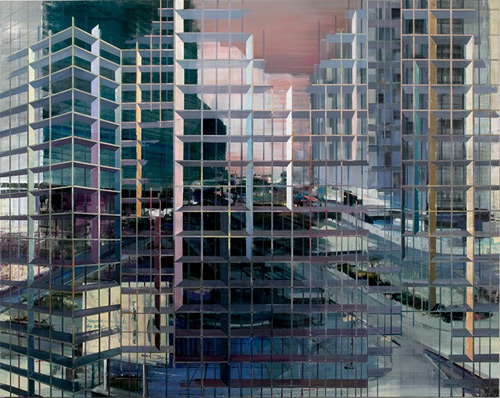
Driss Ouadahi
“Recall that the ghettos of early modern Europe were typically delimited by high walls with one or more gates which were locked at night and within which Jews had to return before sunset on pain of severe punishment, and that their perimeter was subjected to continuous monitoring by external authorities. Note next the structural and functional homologies with the prison conceptualized as a judicial ghetto: a jail or penitentiary is in effect a reserved space which serves to forcibly confine a legally denigrated population and wherein this latter evolves its distinctive institutions, culture and sullied identity. It is thus formed of the same four fundamental constituents—stigma, coercion, physical enclosure and organizational parallelism and insulation—that make up a ghetto, and for similar purposes.
Much as the ghetto protects the city’s residents from the pollution of intercourse with the tainted but necessary bodies of an outcast group in the manner of an ‘urban condom,’ as Richard Sennett vividly put it in his depiction of the ‘fear of touching’ in sixteenth-century Venice, the prison cleanses the social body from the temporary blemish of those of its members who have committed crimes…”
Loic Waquant
Now, the culture industry has peddled the authority structure and its institutions as heroic, glamorous, and sexy; but over the last decade or perhaps two, the romantizing of the police has been wed to an adoration of technology. The political repression of any marginal class, and the punitive treatment of the poor, is given aesthetic expression in the re-introduction of racial and ethnic hierarchies. In the US that means white vs everyone else. In Europe it is white vs East European and Balkan and Arab immigrants. The aesthetics of the underclass, or convicts, and those in ghettos was culturally stripmined by marketing firms going back forty years probably, but the blowback has been that as those styles were resold, branded, and marketed, they allowed too much seepage, and contained, even in diluted form, the values of resistance. Hence the creation today of symbolic ‘exceptions’. The Jay Z black billionaire, Dr. Dre, Beyonce, and these figures become both cautionary symbol for white America, and neutralizing mechanism for the organic codes of resistance in the inner city and barrio. The voice of black or brown resistance is mediated by the conflicting narratives of figures like Jay Z. For those narratives suggest individual qualities of hard work and belief in oneself will be, or at least can be, rewarded. Capitalism works. Meanwhile the technology of control, the militarizing of city police departments has been a reflection of movie consciousness in those who do the policing. The romanticizing of the cop in TV and film has been, of course, consumed by those wanting to be police. Become a cop and be in your own movie !
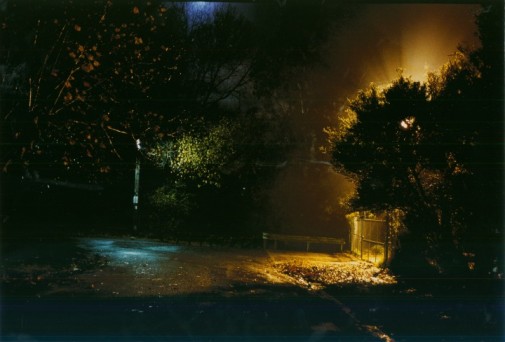
Bill Henson
The American caste system feeds into this feudal landscape of barriers, class segregation, and paranoia. One of the narrative tropes in Hollywood today (far more than earlier decades) is the alien among us; the sleeper cell, the pod person, those with special secret powers. The wish fulfillment of the golden child scenario (the recently cancelled “Believe” is just the religio version of The Tomorrow People). The paranoia is driven by anxiety of contagion. The countless sci fi and horror and just cop shows predicated upon the idea of, essentially, plague. An interesting comparison might be Robert Louis Stevenson’s masterpiece The Ebb Tide, and the plague ship, some current version of viral panic. In any event, the urban landscape today is imprinted and shaped by countless social aesthetic forces. The appropriating of under class stories, makes it easier to resort to the junk science biological narrative of racial inferiority. Today not just racial, for that is too publically contested, but ethno-cultural inferiority. See, the natives love Joss Whedon just as much as we do. The continuing white savior narrative, hence, clearly serves to govern the very idea of narrative.
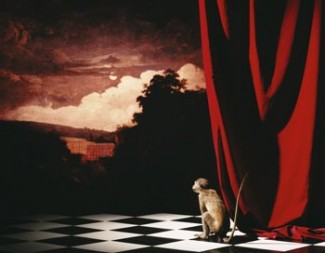
Oliver Richon
But this leads us back to gentrification. For the actual material borders between ghetto and white affluence, are actually far less precise than they are in the mental maps of those on either side, probably. Certainly for the white bourgeoise the reality of heterogeneity, at least along the border regions, is simply not really seen. For this heterogeneity is more disturbing and inducing of psychological vertigo than simple imitation of medieval walled ghettos. So as certain areas fall into decline, due to the destruction of public services, and infrastructure and the collapse of industry employment, the ownership class can come in and purchase cheap property. The various forms or chronologies are well researched; the rent gap, and gerrymandering, and so on. This pattern has been followed countless times, but its also one with secondary narratives attached that are unique in each case. But laid over all this the master narrative essentially remains the same. So, the real barriers, the interdictory spaces, the increase in private security and an increasingly militarized police force, and the actual brutalist architecture are all real. And they serve to mask the reality as well as keep the masses away from the propriator class.
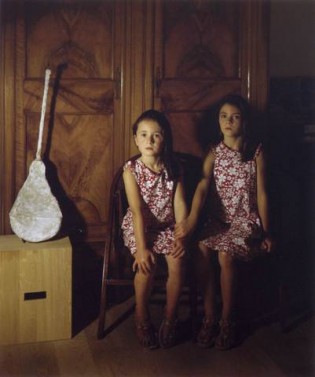
Clegg & Guttman photography.
In the world of TV the depiction of law firms, stock brokers, banks and corporate boardrooms, and even real estate offices are made idyllic and staffed with only size 6 secretaries and six pack hunks in dark suits. The sweaty anxiety ridden paranoia, the bad breath and resentments, the petty feuds and rivalries, the hair plugs, breast augmentations, the botox and personal trainers, alcoholism and prescription medication dependencies, anti depressants, and shrink bills are erased. The point is that for the white ownership class, the fantasy is tinged with desperation. The underclass may dream, and increasingly may dream toxic dreams, but the fear and anxiety of the ownership class NEEDS the IV injections of fantasy, for the real world is crumbling around them and no amount of CCTV can change that. The occasional murder or appearance of a serial killer amid the well tailored business attire and immaculate offices is perfectly OK for TV narrative. What is not allowed is any depiction of systemic decay. No compulsive infidelity, no spousal battery, and no depression that is not treated as a failure of individual responsibility. No discussion of systemic patterns of anything that would suggest the system is flawed. Actually the one thing that is rarely if ever included in the products of the entertainment industry is a sense of tedium, boredom, or unimportance. Nor is the cruelty of privilege ever a part of the plot.
Increasingly the post industrial working class, the proletariat, are forced to endure compulsory programs that demand a moral legitimacy. The bureaucratic state is in the service of stigmatizing. All this enforces the idea of the lower classes being to blame for their own suffering and hardship due to their inborn moral and intellectual shortcomings.
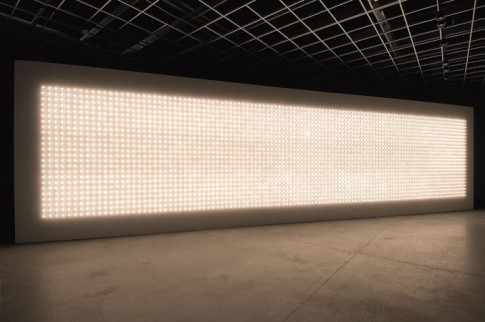
Carston Holler
The New York Times recently reported that in the U.S. there are over sixty thousand incarcerated workers, in jail for lacking proper documentation, who work for a dollar a day.
http://www.nytimes.com/2014/05/25/us/using-jailed-migrants-as-a-pool-of-cheap-labor.html?hpw&rref=us&_r=2
“Last year, at least 60,000 immigrants worked in the federal government’s nationwide patchwork of detention centers — more than worked for any other single employer in the country, according to data from United States Immigration and Customs Enforcement, known as ICE. The cheap labor, 13 cents an hour, saves the government and the private companies $40 million or more a year by allowing them to avoid paying outside contractors the $7.25 federal minimum wage. Some immigrants held at county jails work for free, or are paid with sodas or candy bars, while also providing services like meal preparation for other government institutions.
Unlike inmates convicted of crimes, who often participate in prison work programs and forfeit their rights to many wage protections, these immigrants are civil detainees placed in holding centers, most of them awaiting hearings to determine their legal status. Roughly half of the people who appear before immigration courts are ultimately permitted to stay in the United States — often because they were here legally, because they made a compelling humanitarian argument to a judge or because federal authorities decided not to pursue the case.”
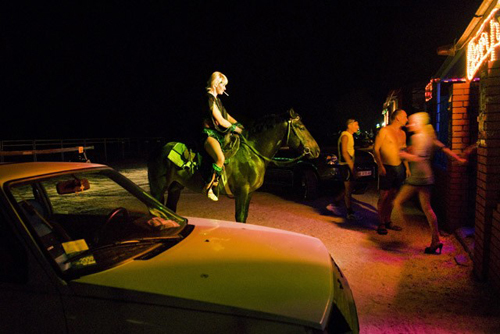
Oksana Yushko, photography.
This is acceptable to most people in the United States because their vision of society is one in which the underclass deserve to be in jail. They are the inhabitants of that shadow land beyond the barricades. So if one connects these dots, one sees the reasons behind the rapacious and venal acceleration of gentrification, as well as the building of a securitized city. It is simply another symptom of the new feudalism. These factors all carry aesthetic expressions, and to turn on almost any mainstream TV show is to see the inscribing of ruling class beliefs and prejudice on the narrative. As I have said before, this isn’t as simple as just attacking crime shows as somehow inherently wrong. Transgression is a part of own formation as humans, but the depiction of the bureaucratic process, of the legal system, of police, and of white collar work is there to make clear where the (as Hollywood executives like to say) ‘rooting interest’ lies.
The psychic architecture of the corporate world, of institutional authority, is based on a feudal vision of the world. The world is built of partitions and encampments and is always securitized. Today, it is an intensified feudalism for this new surplus population, these serfs, must be more effectively controlled. Since there are no jobs, such control must pass to the carceral state. One of the reasons for the desperation of the revanchist society is caught up in the technological realities of mass surveillance, social media, and instant information. As it becomes increasingly difficult to erase the image of the masses, those images must be demonized and stigmatized with more force. And it is here that it is worth contemplating, again, the effects of electronic media on culture. The landscape of the King James Bible was open, acoustic (per McLuhan) and the voice of God could appear as suddenly as the appearance of a man walking out of the darkness in an open desert. The world of Shakespeare was exploring a horizon, and saw man in a landscape that included cities, as well as segregation, and a world of expansion. Today the landscape is without a frame, and hence clings violently to the lingering after image of the Panopticon. The residue of a Benthamite vision of factory and prison. As over simplistic as this description is, my point is to do with how the current sense of enclosure and security is expressed indirectly, and intertexually, in the narrowing of story, the simplifying of plot and grammar the better to keep it in clear view, the reduction of dialogue to resemble brutalist facades to high rise offices (Stallone, or The Terminator et al). There are different additional factors for each element, but the overriding imperative is always the same: the propertied class is working to remove threats to their property, and they see a staggering increase in instability, and into this hyperbranded hyperrealist and highly unstable environment a highly compulsive and anal character enters. One sensing the need to double down on all things repressive.
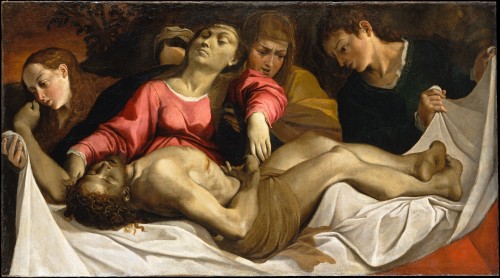
Ludovico Carracci
1582
The prison society of today was probably born around 13th century. It somehow coincided with several other things including 3 point perspective. The world began to be seen spatially as a field to be divided up and parceled out, and punitive correction was visually linked with bars and cages and lines. But also, the idea of guilt was linked to moral certainty. To God, and moral restriction. And guilt and sin and repentance were all tied into religious order. The liberal trends of the Enlightenement have today disapeared, and the reasons are complex, but the return to the idea of caging unwanted humans marks a return to punishment as morally cleansing, and economic pragmatism is also moral. For the punisher, collective or individual, the Puritan grimaces behind the mask. So the landscape of paranoia is intwined with a moral and sado/masochistic insistence on cleansing and purification.
That a rising acceptance of fascism seems to be occuring in the U.S. (and in Europe), it is hard not to see this acceptance expressed in the barely repressed architectural psychology of the neo liberal citizen and material architecture of the city today. The anxiety and anality of the white affluent class is given spatial expression in zones of exclusion, in surveillance space, and in a landscape of boundaries. And in the cruelty and lack of empathy for fellow citizen, who are correctly viewed as new colonial subjects.
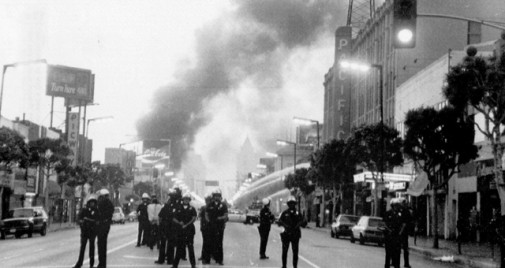
L.A. uprising, 1992. (Dayna Smith photo.)

Reminds me of the Elliot Rodgers’ shooting. One insightful comment I read online commented on how many opportunities he had to travel the world, learn many languages, etc. but he took none of them and instead all his life he was obsessed with gaining status, power, over other people. Life for him was domination, being alpha, being a Nordic Beast. A idee fixe. Monomania. He never loved anything for its own sake — the brief time he engaged with skateboarding, he quickly quit in rage when he realized there are other kids who will be better than him. He said he wanted a relationship, yet he cannot imagine what he will DO with his “girlfriend” other than generic images such as “walks on the beach” or “seeing the sunset”. Can you imagine, life lived pining after a rom-com montage sequence! It’s not surprise he’s a Hollywood child — his emotional vocabulary is kitsch, glossy magazine kitsch. His fixation on pretty blonde girls is not crazy or anomalous, it’s simply the mainstream airbrushed photoshopped objectified women ubiquitous in media, taken to the distilled extreme, reductio ad absurdum. And his anger that “inferior” non-white males could date blonde white girls… well, that has a counterpart in mainstream media too. See this:
http://images.huffingtonpost.com/gen/16600/original.jpg
Is there any surprise that he’d react that way?
What you said here:
“Gentrification in 21st century America is an exercise, in terms of image, in recreating the authenticity of the outside. Enter the mall, and the desired effect of the designers and architects is to make the shopper feel as she or he hadnt entered anywhere at all. The street is now indoors, except its not a street, its not even a simulacra of a street. It’s something else. It is a faux public space in which access or continued occupation is based on the at least apperance of ability to shop.”
“In the world of TV the depiction of law firms, stock brokers, banks and corporate boardrooms, and even real estate offices are made idyllic and staffed with only size 6 secretaries and six pack hunks in dark suits.”
I think is exactly relevant. Elliot Rodgers lived this sort of simulacra all his life. Look at his videos, the way he utters things like “I own a BMW, I own these sunglasses valued at” bla bla bla, why won’t anyone love me. The constantly available image of commodity and shopping is what he grew up with, so imagine the shock when humans can’t be bought that way. It simply stops existing in his vocabulary, how to deal with that. His only vocabulary is that of the video game shooter or action movie hero, because that’s the only fall back he can rely on. I wonder what an in depth piece of cultural theory that focused on the semiotic relationships between rom-coms and actions movies are. They seem to be different genres but they must have an identical underlying structure. It would be an interesting project in academia.
And finally I think this asserts the importance of aesthetic resistance. OF course you can’t be instrumental about this — “oh, if you have good taste, you MUST be morally superior”, for that simply leads to the Auschwitz guard listening to Bach while murdering people — but sometimes, sometimes, bad art makes people do things like this, and good art draws people to the opposite.
What I find really interesting is the amount of grief people went through online to assert that this was somehow an anomaly, that Rodgers wasn’t somehow an extension and REALIZATION of all the things that are happening in mainstream culture. Oh, just a lone crazy guy, why do you have to link this to anything, can’t someone just be a lone psycho. The Seth Rogen link you posted on Facebook. I wonder, what is really going on in their minds? Are they SO unused to critical thinking, that they literally can’t see the system, so to speak, and only see the parts. // or is it something more sinister — that they DO see it, but they are denying it consciously? I wonder what the psychology is. Nowadays, every time I watch an action movie where the hero ends up kissing the girl in the final scene, or whatever bleh, all I can see is the hidden murderous rage towards women that is shown. I mean, literally, it’s THERE — not in the fictional frame, of course, but from the point of view of someone standing outside the frame, that is, if we take the image as rhetoric rather than as fictional reality — it’s THERE — the pixels that represent the testosterone hero is LITERALLY annihilating the pixels that represent the prize girlfriend. How can it not be seen, is my question.
—-
“But this leads us back to gentrification. For the actual material borders between ghetto and white affluence, are actually far less precise than they are in the mental maps of those on either side, probably. Certainly for the white bourgeoise the reality of heterogeneity, at least along the border regions, is simply not really seen. For this heterogeneity is more disturbing and inducing of psychological vertigo than simple imitation of medieval walled ghettos.”
An interesting observation I’ve come to, comparing life in China vs life in the US. Gentrification exists in both places, and really China has become sort of a neoliberal capitalist country itself, so yes, there ARE problems. Living in Beijing as an affluent upper-middle-class expat has given me a sense of disconnect, but I’ve realized that it’s nowhere near as extreme a disconnect as in the USA. I live in a gentrified area, very pretty and affluent housing, and yet 100 meters from my compound is a market where there are street vendors everywhere roasting their barbecues, and small shops. Technically, they’re not supposed to do that, but nobody enforces it, because there is no police state unlike the USA where these vendors would be cleaned out in an instant if they have no license. And you’d regularly have to pass by the alleyways where the relatively well-to-do working class lives. And my family is pretty used to cycling everywhere, as is typical for most people who live here, affluent or not. Now the interesting thing is that I notice when we have some visitors from abroad, especially when they are white (and rich), when they are obliged to walk through these areas, they cringe a little. It’s amazing. They literally don’t like the smell of the street vendors, like it’s going to contaminate them or something. They walk around them. And, sad to say, this attitude does rub off on me, after prolonged exposure, and I don’t like that, it doesn’t turn me into a nicer person.
And, yes, there’s also an American-style strip mall nearby where everything is gated and hypercontrolled. But at least, here in Beijing, next to the strip mall is a market. In American suburbia, there’s only the strip mall, surrounded by hyper-regulated residences.
Exir….yes, absolutley, regards Rodger. I will probably write more about this, but even his father’s reaction and statements feel oddly as if they are in a TV show. And both Rogen and the father exhibit a certain elist grammar and tone. Now yes the father is traumatized. And grieving, but this refusal to accept apologies….as if the public worked for him. Odd tone. But the boy himself; those are perceptive comments Exir, and I felt a similar creepy feeling listening to the boy, because he couldnt imagine what he wanted exactly, beyond possessions. I have a BMW and a Audimars Piguet, now I need that blond to complete the ensemble. And Joe Nava made a smart comment about his self loathing, his bi racial background, and the dissonance with his very Aryan personal mythology, which is of course, the mythology of studio and TV executives. One begins to see just how bankrupt is the vision of the people running the culture industry. And how increasingly nazi like. As i say, I hope to expand on this next post. As a coda: when i lived in Bangkok, I had similar experiences. The thais built these tourist restaurants with american style food and antiseptic surroundings. 99% of thais eat on the street if they eat out….and they very often do. The prime minister will set next to a tuk tuk driver if the fish soup is good at this stand.